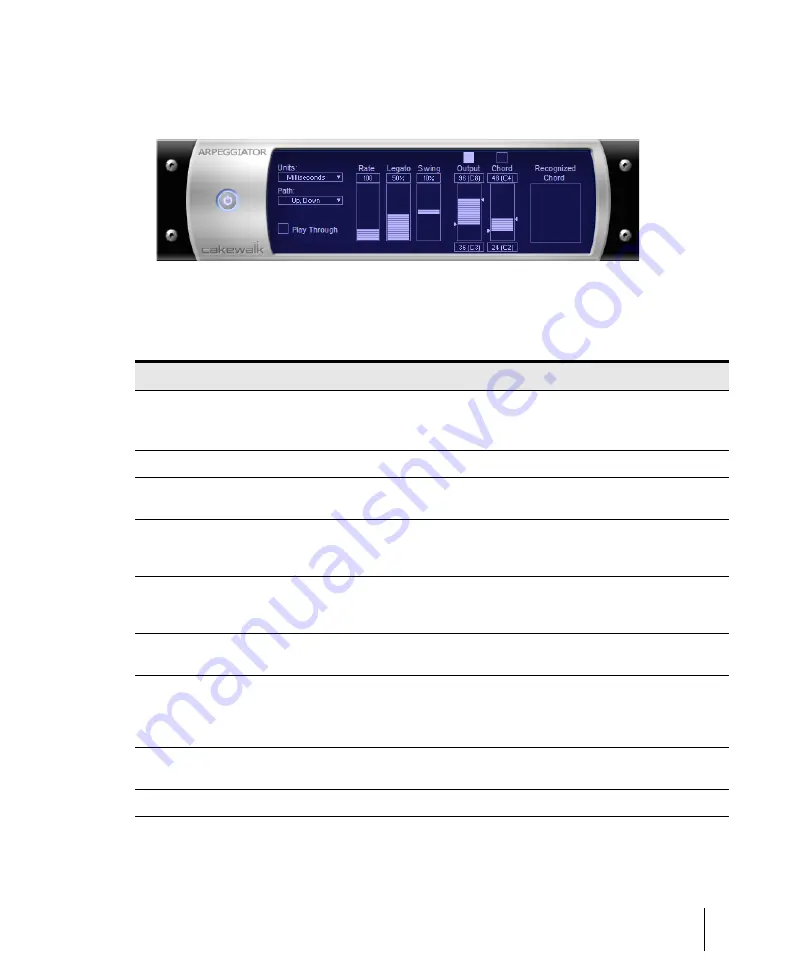
801
MIDI effects (MIDI plug-ins)
Editing MIDI events and continuous controllers (CC)
Adding Arpeggio
Figure 262.
MFX Arpeggiator
The
Arpeggiator
command applies an arpeggio to its input and plays it back in real time. You can
make it arpeggiate with a swing feel, or straight and staccato or legato, vary its speed and direction,
and specify its range.
The parameters used to specify the arpeggiator effect are as follows:
Parameter/Option
Meaning
Swing (%)
The distortion of timing used to produce a swing feel. A value of 0% indicates
a straight rendition; negative and positive values produce distortion of the
timing grid. For more information
about
swing, see
Rate
The delay between successive notes.
Units
The units used to specify the delay. You may specify delay in ticks, in
milliseconds, or as a note duration.
Legato (%)
The smoothness of the notes of the arpeggio. 1 percent plays each notes and
releases it instantly. 99 percent plays each note up to the start of the next
note.
Path
The direction of the arpeggio. Options are
Up, Up
(arpeggios go up),
Up,
Down
(arpeggios go up, then down),
Down, Down
(arpeggios go down),
Down, Up
(arpeggios go down, then up).
Play thru
The disposition of the notes you play to specify the arpeggio. Checked plays
the original notes. Unchecked filters out the original notes.
Specify output range
The range over which the arpeggio plays. Checked specifies that the
arpeggiator repeats notes at each octave over the entire specified range.
Unchecked specifies that the arpeggiator includes only the notes you actually
play.
Lowest note
The MIDI number of the lowest note of the arpeggio. Numbers run from 0 to
127.
Span (Notes)
The number of half-steps in the range. Numbers run from 12 to 127.
Table 146.
Summary of Contents for sonar x3
Page 1: ...SONAR X3 Reference Guide...
Page 4: ...4 Getting started...
Page 112: ...112 Tutorial 1 Creating playing and saving projects Saving project files...
Page 124: ...124 Tutorial 3 Recording vocals and musical instruments...
Page 132: ...132 Tutorial 4 Playing and recording software instruments...
Page 142: ...142 Tutorial 5 Working with music notation...
Page 150: ...150 Tutorial 6 Editing your music...
Page 160: ...160 Tutorial 7 Mixing and adding effects...
Page 170: ...170 Tutorial 8 Working with video Exporting your video...
Page 570: ...570 Control Bar overview...
Page 696: ...696 AudioSnap Producer and Studio only Algorithms and rendering...
Page 720: ...720 Working with loops and Groove Clips Importing Project5 patterns...
Page 820: ...820 Drum maps and the Drum Grid pane The Drum Grid pane...
Page 848: ...848 Editing audio Audio effects audio plug ins...
Page 878: ...878 Software instruments Stand alone synths...
Page 1042: ...1042 ProChannel Producer and Studio only...
Page 1088: ...1088 Sharing your songs on SoundCloud Troubleshooting...
Page 1140: ...1140 Automation Recording automation data from an external controller...
Page 1178: ...1178 Multi touch...
Page 1228: ...1228 Notation and lyrics Working with lyrics...
Page 1282: ...1282 Synchronizing your gear MIDI Machine Control MMC...
Page 1358: ...1358 External devices Working with StudioWare...
Page 1362: ...1362 Using CAL Sample CAL files...
Page 1386: ...1386 Troubleshooting Known issues...
Page 1394: ...1394 Hardware setup Set up to record digital audio...
Page 1400: ...1400 MIDI files...
Page 1422: ...1422 Initialization files Initialization file format...
Page 1463: ...1463 Misc enhancements New features in SONAR X3...
Page 1470: ...1470 Comparison...
Page 1518: ...1518 Included plug ins Instruments...
Page 1532: ...1532 Cyclone Using Cyclone...
Page 1694: ...1694 Beginner s guide to Cakewalk software Audio hardware sound cards and drivers...
Page 1854: ...1854 Preferences dialog Customization Nudge Figure 518 The Nudge section...
Page 1856: ...1856 Preferences dialog Customization Snap to Grid Figure 519 The Snap to Grid section...
Page 1920: ...1920 Snap Scale Settings dialog...
Page 2042: ...2042 View reference Surround panner...
















































